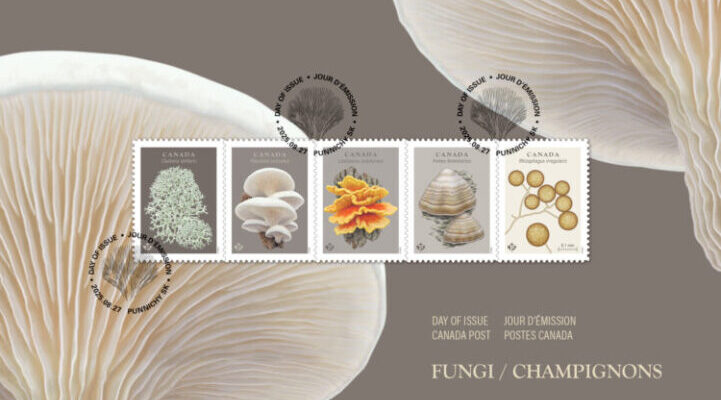
Growing awareness of biodiversity and traditional Indigenous knowledge has renewed Canadians’ fascination with fungi and lichens
Canada Post has issued five new stamps highlighting the beauty of fungi and lichens and their importance to Canadian ecosystems.
Fungi, most of which are microscopic, are important decomposers that break down dead plants and animals, returning nutrients to the soil. Some fungi can store carbon, while others can break down harmful pollutants like plastics and synthetic chemicals.
Most plants rely on fungi for their survival and growth. Since time immemorial, traditional Indigenous practices have also used fungi for medicinal purposes, pigments or food.
 The stamp issue features five species of fungi found in Canada:
The stamp issue features five species of fungi found in Canada:
Star-tipped reindeer lichen (Cladonia stellaris)
Lichens are symbiotic organisms where a fungus and an alga grow as one. Abundant in the North, star-tipped reindeer can be found in every province and territory.
Oyster mushroom (Pleurotus ostreatus)
These shell-shaped mushrooms are a familiar ingredient for many cuisines and were traditionally eaten by Indigenous Peoples.
Chicken of the woods (Laetiporus sulphureus)
With its large, yellow and orange “shelves,” many First Nations traditionally used chicken of the woods to smooth and soften buckskin for clothing.
Tinder fungus (Fomes fomentarius)
Tinder fungus, which makes hard, robust conks on trees that last for several years, was traditionally used as a source of tinder, including by First Nations.
Rhizophagus irregularis (no common name)
This microscopic fungus naturally integrates with plant roots. It can be added to farming soil to enhance crop health.
The stamp images explore the beauty of five species of fungi in a style reminiscent of botanical illustrations. Designed by Jocelyne Saulnier (Joce Creative) and illustrated by Emily S. Damstra, the issue includes five Permanent™ stamps and an Official First Day Cover.
The cancel location is Punnichy, Saskatchewan, near the Touchwood Hills. This wooded area is known to the Cree as a source of tinder fungus (Fomes fomentarius), also called “touchwood fungus” or posâkan in Cree.
Stamp products are available at canadapost.ca and at select postal outlets across Canada.


Thanks Jody
Punnichy is part of my old stomping ground on the Cree treaty land my families owned at settlement and one farm remains on land between two large Cree reserves.
Thanks for your effort and for enlightening me.
Bille
Hi Bille
This really hits home for you then.
I learned a little something too.:)
What is a cancel location? I know the Touchwood Hills area.
Hi Bille
I didn’t know the answer to this so I did a little search. Hope this information helps.
The cancel location on a Canadian stamp indicates the post office where the stamp was marked as used to process mail, such as with a postmark, or for a first-day-of-issue event.
Canada Post Director of Stamp Services Jim Phillips said the “honour of being selected as the cancellation site for a stamp does not entail anything specific – nor does it require any special action by the chosen post office.”
“The site is simply featured as an added honour to reflect the fact that the community holds a special connection with the stamp subject,” he said, adding all OFDCs issued for the stamp bear a “special” cancellation mark featuring the post office’s location; the issue date; and “in some cases” an image of relevance to the stamp subject.